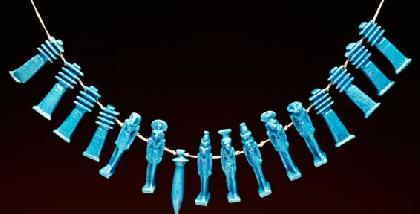
An amulet is an object that is either worn (usually as jewelry), carried (perhaps as a weapon), or put at a certain place with a ritual significance (such as a specific place within a home, or near a crop field). It was believed that it has magico-religious powers. Examples of such powers would include: the ability to protect against a specific type of danger, the ability to cure disease, or the ability to give preternatural strength to the wearer. Amulets started out in prehistory as found objects that seemed to be of special quality. Examples included animal parts (such as a tooth, an ear, a tail, or a foot) taken from a particular animal thought to have certain desirable traits associated with the purpose of the amulets. They could also be plants, herbs, or a mixture of herbs in a bag, tied or otherwise secured in place on a specific body part. Amulets could also come from the mineral world, as a stone of a particular shape or quality. Meteoric bits which are often magnetic, stones with natural holes in them, geodes, and crystals were all viewed as especially powerful. An amulet was basically a charm, often inscribed with a spell, magic incantation or symbol that protects the wearer against evil or provides aid and magical benefits. Amulets can aid or provide healing, luck or protection or even act as a double or replacement for an organ or limb.
There were several Ancient Egyptian words for amulets, most notably 'Sa' and 'Wedjau', which were associated with protection, well-being, and prosperity. A large variety of amulets were placed on the body and scattered among the wrappings to ensure the safety of the body and any easy passage into the Afterlife.Several of the spells in the Book of the Dead were intended to be spoken over specific amulets, which were then placed in particular places on the body of the deceased. A list of important funerary amulets from Ancient Egypt actually appears in the MacGregor papyrus. Both royal and non-royal individuals included amulets in their mummy bandages. King Tutankhamun had over 140 amulets scattered through his wrappings. The Book of the Dead specifically mentions certain amulets that have magical obligations to the deceased, notably the headrest and Wadj Pillar, which should be included with the mummy.
An amulet's power comes from its shape, material, and color. Green and blue stones, glass or faience signified resurrection and rebirth; hematite was used for amulets providing strength and support; carnelian, jasper, red glass or red faience were used for any amulet that symbolized blood, energy, strength, power and solar force. Although funerary amulets were important throughout Egyptian history, the type and number of amulets used changed over time. However, there were certain amulets that were fairly standard throughout the history of Egypt. Perhaps the best known Ancient Egyptian amulet is the Wedjat (or the 'Eye of Horus'). This amulet was supposed to represent the eye of god Horus or of god Re and protected the wearer against all evils by taking on the power of the god. Amulets representing the eye are found all over the body, interspersed with the wrappings.
